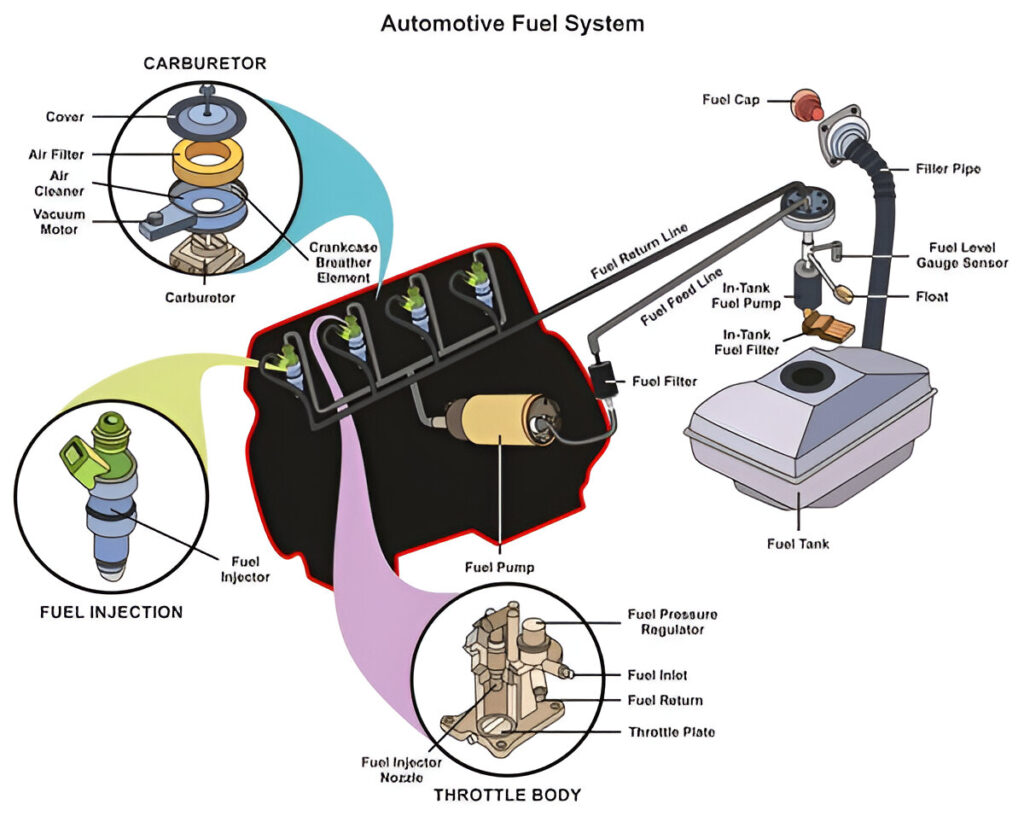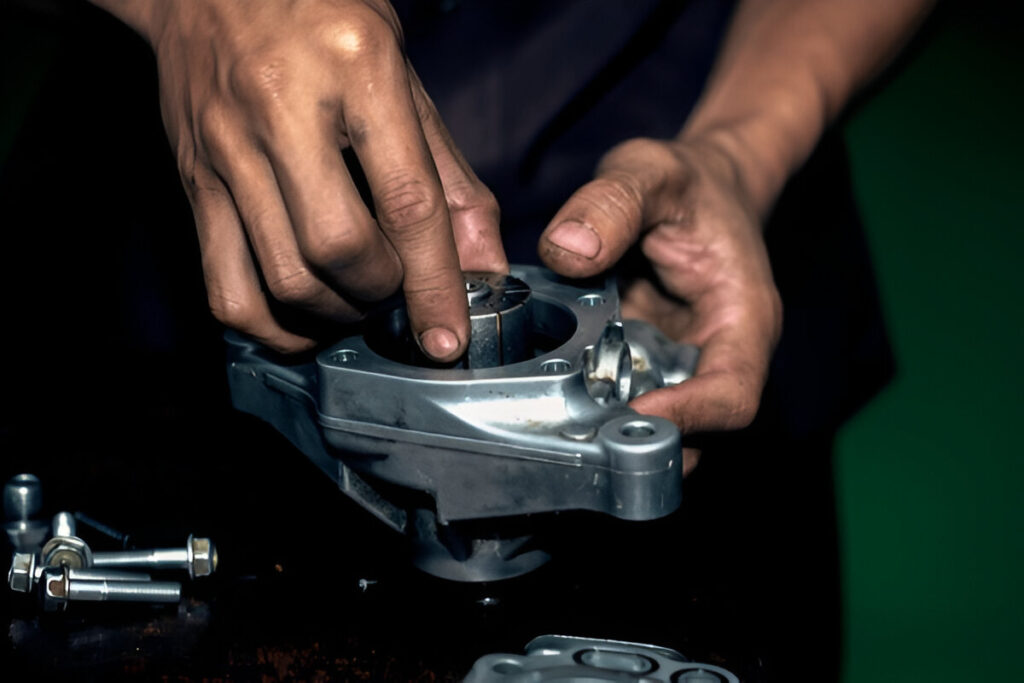Cars have made our daily lives much easier and more comfortable. But it becomes annoying or troublesome when technical problems arise in it, especially during long-distance journeys or important trips. One of the various problems is the fuel pump problem. Although this happens very rarely. However, if the problem can be eliminated before it becomes a problem, it will be a relief for you. Therefore, it is necessary to have detailed knowledge about bad fuel pump systems.
What is the bad fuel pump symptoms and How to test Fuel Pump Issues Effectively?
Learn how to effectively diagnose bad fuel pump symptoms with our expert guide. Gain valuable insights and practical tips for troubleshooting fuel pump problems.
Fuel pump: With the help of a fuel pump, it takes a small amount of petrol from the reservoir and supplies it to the float chamber of the carburetor. It is called a fuel supplier or fuel pump. The following three types of fuel pumps are used in petrol engines, viz.:

(a) Mechanical or AC fuel pump: This type of pump is driven by eccentric cam lobes on the camshaft, and hence, it is also called a mechanical pump. Engines with I-shaped heads use one AC pump, while engines with V-shaped cylinders use two.
When the engine is running, the camshaft rotates with it, and its camshaft pump drives the rocker arm at regular intervals.
At this time, the inner end of the rocker arm pulls the push rod down against the diaphragm spring, partially evacuating the pumping chamber. As a result, the intake valve opens, allowing fuel from the reservoir to enter the pumping chamber. Later, when the cam lobe moves away from the rocker arm, the diaphragm spring pushes the diaphragm upwards. As a result, pressure is discharged due to compression in the pumping chamber.
The valve opens, and fuel from the pumping chamber passes through the discharge valve to the carburetor. At this time, the intake valve is closed. Again, the intake valve opens, and the exhaust valve remains in the closed position. This is how automatically controlled or AC fuel pumps work.
When the float chamber of the carburetor is full of oil, the pumping action by the AC pump does not take place. This is because the float chamber of the AC pump is closed by the needle valve. As a result, the oil pumped by the diaphragm cannot enter the float chamber. In this case, the diaphragm continues to pump oil, causing the diaphragm spring to compress due to the oil pressure, and the diaphragm can no longer pump oil. When the oil level in the float chamber drops, the needle valve opens, and the pump resumes pumping oil. In this way, the automatically regulated pump continuously supplies and regulates the oil.
(b) Fuel pump of electric nature:
As it is electrically driven, it is called an electric fuel pump.
This pump is classified into three categories, viz.:
- Diaphragm type
- Bellows type
- Pusher type
Diaphragm and bellows-type electric fuel pumps are very similar in operation. The principle of operation of the automatically controlled or AC pump is also partially similar to these two pumps. AC pumps mechanically drive the fuel pump diaphragm, while diaphragm and bellows electric fuel pumps have diaphragms and bellows driven by electromagnets. In these pumps, the electromagnet is magnetized or demagnetized as required, driving the diaphragm or bellows. As a result of absorption and compression in the pumping chamber, the fuel moves from the fuel reservoir to the carburetor. Such a fuel pump is connected to the battery circuit. The pump operates with a flexible metal bellows, armature, solenoid, return spring, and a pair of connection points. As soon as the ignition is switched on, the electromagnet becomes magnetized, turning into a strong magnet that pulls the armature downward. This pull causes the bellows to expand downward, as it is connected to the armature.
The expansion of the bellows creates a vacuum inside it. This vacuum pulls the intake valve open, allowing fuel from the reservoir to enter the pump. At the same time, the return spring is compressed and energized as the armature descends.
At this time, when the armature reaches its lowest position, the contact point opens and turns off the circuit. As a result, the electromagnet loses its magnetism due to the lack of electrical energy. The previously compressed return spring then pushes the armature and bellows upward, causing the bellows to compress.
This compression causes the intake valve to close and the exhaust valve to open as the fuel is pressurized inside the bellows. The fuel then passes through the exhaust port to the carburetor. This is how a bellows-type electric fuel pump works.
An electric fuel pump of a pusher nature delivers fuel from the reservoir to the carburetor by pushing. This pump unit is attached to the bottom of the fuel tank. It has a small electric motor connected to the pump shaft, which rotates the pump shaft. The impeller attached to the other end of the shaft rotates and pushes the fuel to the carburetor. This pump operates like a volute-type centrifugal pump with an impeller. This is how an electric fuel pump of a pusher nature wor
(c) Combined fuel pump: This type of fuel pump functions as a combination of an automatic control pump and a vacuum pump. One part of the pump supplies petrol fuel to the carburetor, while the other part, or the vacuum pump section, creates a vacuum for the vacuum-operated windshield wipers.
The working principle of a vacuum pump is similar to that of a normal fuel pump, except that it pumps air instead of fuel to create a vacuum.
Windshield wipers primarily receive a vacuum from the intake manifold. At low engine speeds, the vacuum is greater. However, at higher speeds, the vacuum is generated at a lower rate. At this point, the vacuum pump provides the vacuum needed to drive the windshield wiper.
Both parts of the combined fuel pump are operated by the same rocker arm, with separate rocker arm brake linkages used to control the two parts. The intake line of the vacuum section is connected to the windshield wiper, and the exhaust line is connected to the intake manifold. The fuel pump consists of a diaphragm and two valves, similar to a standard fuel pump.
Bad fuel pump symptoms
There are mainly three types of problems that can occur in an AC fuel pump:
- The output pressure may be too low or too high.
- The suction pressure or vacuum may drop.
- The output volume may be too low or too high.
The above tests are required to diagnose these AC fuel pump problems.
Reasons for high and low delivery pressure and volume of AC fuel pump: Reasons for high and low delivery pressure and volume of the pump:
(1) When fuel enters between the layers of the diaphragm of the pump, the volume of the diaphragm increases.
(2) When the flexibility of the diaphragm is lost.
(3) When the surface of the diaphragm becomes hard and firm.
(4) If the connection of the rocker arm with the diaphragm is jammed.
5) Using stronger diaphragm spring.
Reasons for low pump delivery pressure and volume:
(1) Rocker arm, push rod or rocker arm pivot pin corroded.
(2) When the diaphragm is perforated.
(3) When the diaphragm spring is weakened.
(4) If the fuel pump valves are jammed.
(5) If the fuel line is leaking or constricted.
Fuel Pump Dismantling and servicing:

- First, disassemble the pump, pump reservoir, and carburetor connection lines together with the necessary equipment.
- Disconnect the pump from the engine by loosening the two mounting nuts attached to the engine.
- Parts are disassembled by soaking the pump in a solution containing kerosene or petrol.
- Clean the parts by scrubbing with scrapers and brushes, and thoroughly clean them with new oil to remove any dirty oil. The pump’s components, such as the check valve, strainer, diaphragm, pull rod, and push rod, should be removed.
- When opening the cover of the AC pump, mark the parts to avoid any difficulties during reassembly.
- The pull and push rod are connected to the rocker arm. The rod with the diaphragm is pushed down to open it.
- Apart from the diaphragm, oil seal, and gasket, other parts should be cleaned by immersion in oil.
- After washing, place the parts on a clean cloth and wipe them dry.
Fuel Pump Servicing and Reassembly:
After cleaning, the AC pump parts are checked for serviceability, with each new or working part evaluated. Some parts need to be replaced after a test or crew check. AC pump kits are used for this work, which typically include the AC pump check valve, diaphragm, diaphragm spring, gasket, oil seal, etc.
After servicing, the AC pump parts are assembled in the following sequence:
- The new diaphragm of the AC pump must be fitted with the pull and push rod, spring retainer, oil seal, etc., to connect the pull and push rod to the rocker arm under pressure.
- Next, install the two valves in the AC check valve body, and then connect this body to the pump body.
- Attach the top cover of the check valve body to the pump body using a bolt and gasket, or by securing it with a nut. After reassembly, the AC pump parts are connected to the engine following testing. For the test, a container with some petrol is pumped by the rocker arm, with the intake line of the pump immersed in it. If oil comes out of the pump discharge port at a pressure of 3 to 7 pounds, the pump is functioning correctly.
- The pump must be connected to the engine in the correct position. It is then connected to the fuel tank and carburetor. The port at the bottom of the pump, which controls the normal atmospheric pressure, should not be closed for any reason. Otherwise, even if the pump is working properly, fuel will not be pumped to the carburetor.
How to test Fuel pump
FUEL PUMP PRESSURE TEST: While performing the test, the A.C. pump is connected to the engine, and the following tasks are to be performed sequentially:
(a) Disconnect the fuel line from the inlet port of the carburetor and connect the fuel pump pressure gauge between the fuel line and the carburetor using a special attachment.
(b) Start the engine at 500 RPM (if there are no specific instructions from the AC pump manufacturer). Follow the manufacturer’s instructions if provided.
(c) Note the reading from the dial of the pressure gauge and compare it with the manufacturer’s specifications. Typically, the output pressure or delivery pressure of an AC fuel pump ranges from 0.3 to 0.5 PSI.
Fuel Pump Vacuum Test: During this test, the fuel pump shall be connected to the engine, and the procedure shall be performed as described below:
(1) Disconnect the fuel line from the inlet port of the AC pump and connect a fuel pump vacuum gauge between the fuel line and the carburetor using a special attachment.
2) Start the engine and run it at idle speed.
(3) Note the reading from the dial of the attached vacuum gauge and compare it with the manufacturer’s specifications. Normally, the vacuum pressure of the fuel pump should not be less than six inches of mercury.
(4) Finally, stop the engine. At this point, the needle of the vacuum gauge should indicate vacuum pressure for at least ten seconds.
If the vacuum gauge does not indicate vacuum for ten seconds after the engine is turned off, or if the vacuum pressure is less than six inches of mercury, it should be assumed that there is a fuel leak or a fuel line failure. Identify the cause of the issue and make the necessary repairs.
Volume Test: During this test, the pump must be connected to the engine, and the following steps must be performed sequentially:
(1) Disconnect the fuel line from the inlet port of the carburetor. Attach a rubber pipe of the required size to the fuel line, and insert the other end of the pipe into a marked container.
(2) Start the engine and simultaneously start a stopwatch. Keep the engine running at idle speed, using the fuel in the float chamber of the carburetor. Stop the stopwatch when the engine runs out of fuel and stops.
(3) Note the amount of fuel collected in the marked container and the time recorded on the stopwatch.
(4) Finally, check the manufacturer’s specifications. Typically, a good AC fuel pump can deliver a pint of fuel in 15 to 20 seconds at idle speed.
If the pump’s delivery capacity does not match the manufacturer’s specifications, the pump must be considered defective, and necessary repairs should be made.

